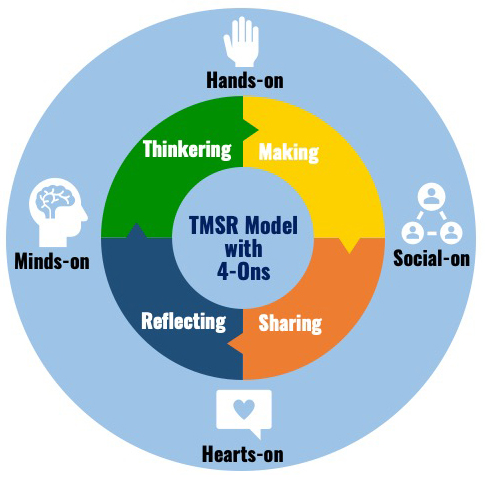The TMSR instructional design model with four "Ons" can be used to create effective online learning environments with collaborative project-based learning activities that help facilitate student engagement and connection.

Project-based learning (PBL) is a teaching method that calls for students to actively build knowledge by producing something. PBL assignments are designed to help learners observe and explore problems and content and make connections between their existing knowledge and new ideas. When designing for PBL, instructors need to scaffold learning technologies to create collaborative, active learning opportunities that encourage students to find and share solutions to problems by completing hands-on, inquiry-based activities that incorporate tangible products and situated learning environments.Footnote1 These real-world activities guide, challenge, and engage learners by allowing them to participate in experiences and by exposing them to subject matter experts' thinking processes.
PBL is different from merely completing a project or participating in problem-based learning. In PBL, the project is the vehicle for delivering important knowledge, skills, or concepts in alignment with instructional goals. That is, the project shapes the curriculum and corresponding instruction. Because students usually have not yet received formal instruction in the relevant background material, the process of finding a solution is more important than the final product in PBL.Footnote2
One of the benefits of PBL is that it allows learners to construct knowledge actively through online social interactions. Until recently, most group work was conducted in person. In the post-pandemic era, many higher education institutions have identified the need to transform their traditional brick-and-mortar settings into flexible and hybrid online models.Footnote3 In turn, using PBL in online learning environments has created a need for specific teaching approaches that move beyond asynchronous or discussion-based online teaching and incorporate interactive online projects. The rapid growth in sophistication and adoption of videoconferencing applications such as Zoom and collaboration tools like Google Chat has enabled the implementation of PBL in online environments in ways that effectively engage learners and promote collaboration. Learners' needs and appropriate instructional design models should be considered when designing PBL activities.
While PBL in online environments can make content accessible and thinking visible, help students learn from and with others, and promote shared learning communities, most PBL models or frameworks are tailored for in-person teaching and individual or pair-based learning rather than collaborative, active online learning.Footnote4 We developed and implemented collaborative PBL with tools that provide student-centered active learning in virtual environments. PBL activities were designed through the lens of constructionism, a learning theory based on the premise that students construct knowledge by making something and engaging in real-word production processes. Our model consists of four stages ("thinkering," making, sharing, and reflecting [TMSR]) and four "on" engagement modes (hands-on, minds-on, hearts-on, and social-on).
The TMSR Instructional Design Model
The four stages in the TMSR instructional design model guide instructors' lesson planning for creating and implementing online collaborative PBL (see figure 1). The four stages do not have to be completed in a specific sequence, and the reflection component may happen at the end of each stage.

Four TMSR Stages
Thinkering—a term created by combining the words "thinking" and "tinkering"—refers to thinking and brainstorming through tinkering.Footnote5 As such, the thinking process happens during unstructured and structured activities. For example, unplugged coding activities allow novice learners to experiment with coding concepts without learning computer languages or tool functions. Thinkering can also include coding activities that require students to design original content, solve problems, and create innovative solutions.
Making is the process of creating artifacts—from design and planning to creation. It can be structured (with step-by-step instructions) or unstructured (with broader goals or objectives). Making builds on the new skills, knowledge, and ideas gained during the thinkering process. Examples include following steps to make artifacts and using a template to make a roller coaster with basic materials.
Sharing is a process in which team members discuss and communicate their ideas and find and discuss optimal solutions. While sharing and exchanging ideas may also happen during the thinkering and making stages, in the TMSR model, sharing is an explicit stage guided by the instructor to promote in-depth, constructive discussions based on students' learning, thinkering, and making experiences. Sharing ideas can happen as team members work to achieve a common goal or try to complete an individual portion of a task to contribute to a collaborative goal. Technology tools like Padlet and Jamboard allow students to share ideas and solutions visually. These tools provide an effective environment for students to discuss their thoughts, creations, discoveries, and experiences related to the course concepts while interacting socially and constructing new learning.Footnote6
Reflecting is a process in which team members describe their learning and explore how it has changed and how it might relate to future learning experiences.Footnote7 This skill is often undervalued in traditional classrooms, where lessons tend to focus on content delivery. Reflecting includes four criteria: (1) it is meaning-making and moves a learner from one experience to the next with a deeper understanding of the relationships with and connections to other experiences and ideas; (2) it involves systematic, rigorous, and disciplined thinking that is rooted in scientific inquiry; (3) it happens through interactions with others in a community; and (4) it requires attitudes that value the personal and intellectual growth of the learner and others. Reflecting may occur at the end of each stage of the TMSR model or at the end of a project.Footnote8
Modes of Engagement during Learning: 4-Ons
Figure 1 illustrates the four modes of engagement during learning—hands-on, minds-on, hearts-on, and social-on (4-Ons)—that benefit PBL implementations in collaborative online learning environments. The four modes are informed by Bloom's taxonomy of educational objectives and the framework for transformative sustainability learning (TSL) proposed by Yona Sipos, Bryce Battisti, and Kurt Grimm. Bloom's taxonomy defines three learning domains (cognitive, affective, and psychomotor), while the learning objectives in the TSL framework are organized by head (cognitive), hands (psychomotor), and heart (affective).Footnote9
When integrating arts, technologies, and music into STEM education, "minds-on" learning is emphasized to promote reflection and meaningful understanding. Minds-on learning embraces head-on learning, which focuses on the cognitive aspects of learning. We adopted the term "minds-on" learning and expanded it to include head-on cognitive learning.Footnote10 "Hands-on" learning refers to psychomotor engagement during learning, and "hearts-on" learning focuses on emotional, motivational, and affective engagement during learning. Finally, since our goal was to strengthen online PBL—where delivering collaborative tasks can be difficult and engagement and interaction are crucial for maintaining students' attention—we added "social-on" learning, which emphasizes situated collaborative learning.Footnote11 The 4-Ons do not work separately; they coexist and complement each other. All four modes should be considered during each stage of the TMSR model to optimize student engagement.
Example Activities
The example activities (along with which engagement mode(s) would be emphasized during learning) in table 1 demonstrate how each stage of the TMSR model could be integrated into an online course.
| Stages | Example Activity | Engagement Modes during Learning | Resources |
|---|---|---|---|
| Thinkering |
|
Hands-on Minds-on Social-on (if the activity is conducted as a group) |
Coding programs such as Scratch and Hopscotch |
| Making |
|
Hands-on Minds-on Hearts-on |
Paper-based coding blocks Craft resources |
| Sharing |
|
Social-on Minds-on Hearts-on |
Padlet or Jamboard Synchronous meeting room |
| Reflecting |
|
Social-on Minds-on Hearts-on |
Synchronous meeting room Padlet or Jamboard |
Conclusion
In online environments, PBL tends to be siloed or carried out at home or independently, and learners generally don't have a sense of connectedness. However, online teaching is evolving beyond being an asynchronous discussion-based modality.Footnote12 Instructors can use the TMSR model with 4-Ons to develop and instruct effective collaborative PBL while creating an engaging online learning environment where learners feel connected to each other.Footnote13 The TMSR model is flexible and fits easily into any given project. We encourage online instructors to adopt and test the model and hope it will be further enhanced as online teaching evolves and improves.
Notes
- Michael Prince and Richard Felder, "The Many Faces of Inductive Teaching and Learning," Journal of College Science Teaching 36, no. 5 (March/April 2007): 14–20; Joseph S. Krajcik and Phyllis C. Blumenfeld, "Project-Based Learning," in Cambridge Handbook of the Learning Sciences, ed. R. Keith Sawyer (Cambridge, UK: Cambridge University Press, 2006), 317–334. Jump back to footnote 1 in the text.
- Prince and Felder, "Inductive Teaching and Learning," 14–20. Jump back to footnote 2 in the text.
- Phyllis C. Blumenfeld et al., "Motivating Project-Based Learning: Sustaining the Doing, Supporting the Learning," Educational Psychologist 26, no. 3–4 (1991): 369–398; Krajcik and Blumenfeld, "Project-Based Learning," 317–334; Milan Kubiatko and Ivana Vaculová, "Project-Based Learning: Characteristics and the Experiences with Application in the Science Subjects," Energy Education Science and Technology Part B: Social and Educational Studies 3, no. 1 (2011): 65–74; Helen Donelan and Karen Kear, "Online Group Projects in Higher Education: Persistent Challenges and Implications for Practice," Journal of Computing in Higher Education (March 2023): 1–34; Panagiotis Kosmas et al., "The Digitalization of Teaching Practices in K-12 Education: Insights from Teachers' Perspective," in Educating for a New Future: Making Sense of Technology-Enhanced Learning Adoption 17th European Conference on Technology Enhanced Learning, EC-TEL 2022, Toulouse, France, September 12–16, 2022, Proceedings, eds. Isabel Hiliger et al. (New York: Springer, 2022), 145–158. Jump back to footnote 3 in the text.
- Scott W. Slough and John O. Milam, "Theoretical Framework for the Design of STEM Project-Based Learning," in STEM Project-Based Learning, eds. R.M. Capraro, M.M. Capraro, and J.R. Morgan (Rotterdam: SensePublishers, 2013), 15–27. Jump back to footnote 4 in the text.
- Michael Michalko, Creative Thinkering: Putting Your Imagination to Work (New York: New World Library, 2011). Jump back to footnote 5 in the text.
- Mary-Ann Shuker and Rob Burton, "Educational Technology Review: Bringing People and Ideas Together with Padlet," Journal of Applied Learning & Teaching 4, no. 2 (August 2021): 121–124. Jump back to footnote 6 in the text.
- Arthur L. Costa and Bena Kallick, Learning and Leading with Habits of Mind (Reston: Association for Supervision and Curriculum Development, 2008). Jump back to footnote 7 in the text.
- Carol Rodgers, "Defining Reflection: Another Look at John Dewey and Reflective Thinking," Teachers College Record 104, no. 4 (April 2002): 845. Jump back to footnote 8 in the text.
- Benjamin S. Bloom, Max D. Engelhart, Edward J. Furst, Walker H. Hill, and David R. Krathwohl, Taxonomy of Educational Objectives: The Classification of Educational Goals, Handbook I: Cognitive Domain (New York: David McKay, 1956); Yona Sipos, Bryce Battisti, and Kurt Grimm, "Achieving Transformative Sustainability Learning: Engaging Head, Hands and Heart," International Journal of Sustainability in Higher Education 9, no. 1 (2008): 68–86. Jump back to footnote 9 in the text.
- Mark R. Young, "Experiential Learning = Hands-on+Minds-on," Marketing Education Review 12, no. 1 (2002): 43–51. Jump back to footnote 10 in the text.
- Aurel Pera, "The Social Aspects of Technology-Enhanced Learning Situations," Geopolitics, History, and International Relations 5, no. 2 (2013): 118–123. Jump back to footnote 11 in the text.
- Hanni B. Flaherty, "Using Collaborative Group Learning Principles to Foster Community in Online Classrooms," Journal of Teaching in Social Work 42, no. 1 (January 2022): 31–44; Kosmas et al., "Digitalization of Teaching Practices," 2022. Jump back to footnote 12 in the text.
- An example of employing this model with four "ons" and evaluating its effectiveness was discussed in Heejung An, Woonwee Sung, and So Yoon Yoon, "Hands-on, Minds-on, Hearts-on, Social-on: A Collaborative Maker Project Integrating Arts in a Synchronous Online Environment for Teachers," TechTrends 66 no. 4 (May 2022): 590–606. Jump back to footnote 13 in the text.
Heejung An is a Professor in the Department of Educational Leadership and Professional Studies at William Paterson University College of Education.
Woonhee Sung is an Assistant Professor of Instructional Technology at the University of Texas at Tyler School of Education.
© 2024 Heejung An and Woonhee Sung. The content of this work is licensed under a Creative Commons BY-NC-ND 4.0 International License.
